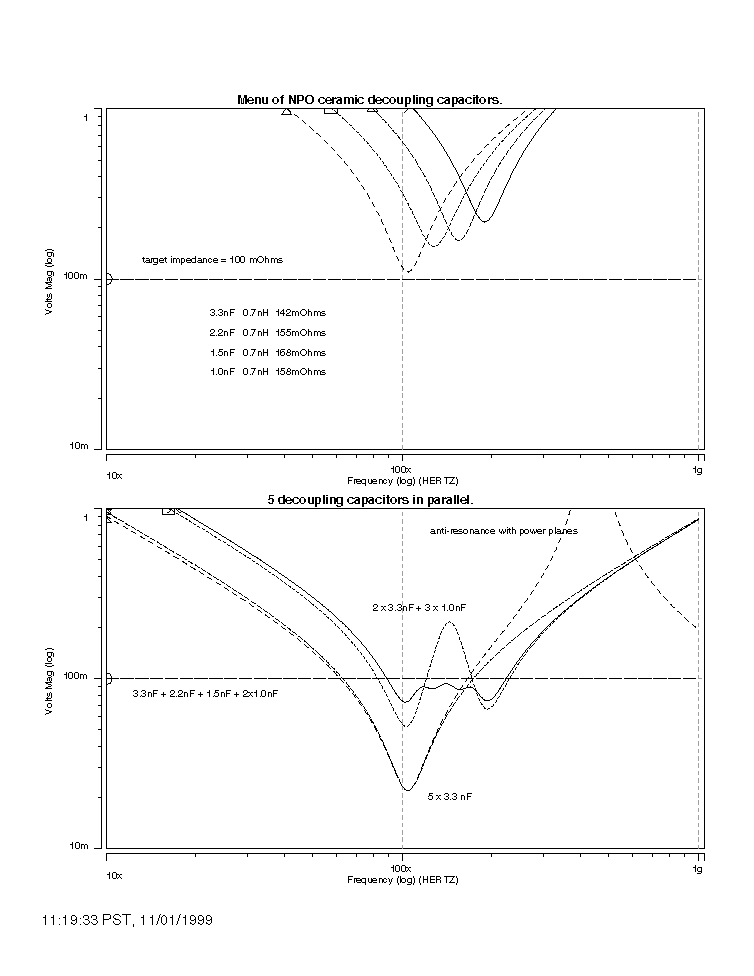From: Larry Smith ([email protected])
Date: Mon Nov 01 1999 - 11:52:30 PST
Arrigo - It is true that inductance is an extremely important parameter
for decoupling capacitors and a low inductive impedance between the
power rails is useful in reducing noise.
But to get a complete picture, we need to consider the L, C and R of
the decoupling capacitors. A good model for ceramic decoupling
capacitors is a series RLC circuit. If we had perfect (lossless) L and
C, the decoupling capacitor would be zero impedance(!) at the series
resonant frequency which is 1/sqrt(LC). But, all capacitors have loss
which is usually represented as equivalent series resistance, ESR. For
many ceramic decoupling capacitors, the ESR is a lower impedance than
jwL or 1/jwc, leading to nice minimum impedance at resonant frequency.
A gif file is attached that shows frequency domain spice analysis of a
small menu of individual 0805 size decoupling capacitors:
3.3nF 0.7nH 142mOhms
2.2nF 0.7nH 155mOhms
1.5nF 0.7nH 168mOhms
1.0nF 0.7nH 158mOhms
Suppose we have a system that requires a power supply with an impedance
of 100 mOhms between 100 and 200 MHz. We have room for just 5
capacitors that are 0805 size. What are the best 5 capacitors that we
can choose?
None of the capacitors on the menu have 100 mOhms of impedance, but if
we parallel them up we can get less than 100 mOhms of impedance.
First, try using 5x3.3nF. The spice analysis in the lower panel of the
.gif file shows that at 100 MHz, we are far below 100 mOhms, but do
not meet requirements at 200 MHz.
We might try using 2x3.3nF in parallel with 3x1.0 nF. This combination
works well at 100MHz and 200MHz, but leaves a bad 'anti-resonance' at
150MHz. The anti resonance occurs when one capacitor has gone
inductive and another capacitor is still capacitive. It forms a
parallel RLC circuit that has a dangerous high impedance at some
frequency.
The best choice is to use one of each of the above capacitors and double
up on the 1nF, for a total of 5 capacitors. The five capacitors in
parallel make a nice flat impedance between 100MHz and 200MHz. The ESR
for lower value capacitors tends to be higher because fewer plates are
used in the construction.
A word of warning: Power planes have very high quality (low inductance,
low ESR) capacitance. Four mil thick FR4 has a capacitance of 225 pF
per square inch. If we use discrete capacitors to decouple a set of
FR4 power planes, there will be a large antiresonance at some higher
frequency. The lower panel shows the antiresonance at about 500 MHz
when 4 square inches of power plane are decoupled with 5x3.3nF. The
high Q circuit formed by low ESR capacitors attached to power planes
through inductive vias/pads can result in EMI problems.
Several of us at Sun have published a paper in the IEEE Transactions on
Advance Packaging, Aug 1999, Vol 22, Number 3. The paper gives much
more details on power distribution and decoupling capacitors. A soft
copy is available at:
http://www.qsl.net/wb6tpu/si_documents/docs.html
regards,
Larry Smith
Sun Microsystems
> Date: Sun, 31 Oct 1999 23:56:05 -0800
>
> Dear SI experts,
>
> I have a question on the article posted on Dr. Johnson's web site at
>
> http://www.sigcon.com/news/2_3.htm
>
> entitled `Bypass Capacitor Layout'. At the end of the article
> Dr. Johnson's states that since the only parameter that affects the
> performance of bypass capacitors at high frequency is their parasitic
> inductance, there is no point in using many small capacitors, rather
> the highest value capacitor in the chosen package should be used.
>
> Isn't this in contraddiction with the principle, also stated in the
> book, that many small capacitors are a better choice since the total
> parasitic inductance is lower? After the series resonant frequency
> of 1/sqrt(LC) the impedance goes up with 20 dB/decade slope so the
> only way to decrease it is by lowering either L or C, so both L and C
> are important.
>
> Am I missing something?
>
> Thanks in advance,
>
> -Arrigo

**** To unsubscribe from si-list: send e-mail to [email protected]. In the BODY of message put: UNSUBSCRIBE si-list, for more help, put HELP. si-list archives are accessible at http://www.qsl.net/wb6tpu/si-list ****
This archive was generated by hypermail 2b29 : Tue Feb 29 2000 - 11:39:29 PST